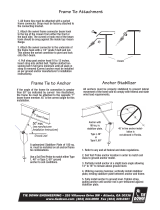
110 Tender/Sport - Owners Manual
Section 3- Fuel System10
Oil Usage
OIL: 110 TENDER/SPORT (4-Stroke)
Use of Mercury or Quicksilver SAE 10W-30 mult-
viscosity 4-stroke outboard oil for general, all-tem-
perature use is recommended. NEVER use 4-cycle
engine oil that is not certified to meet or exceed any
one or combination of the following American Pe-
troleum Institute (API) Sevice Classification SH, SG
SF, CF-4, CE, CD, CDII. Severe engine damage may
result from use of an inferior oil.
SAE 10W-30 viscosity oil is recommended for
use with all temperatures.
SAE 25W-40 viscosity oil may be used at tem-
peratures above 40º F (4º C).
DO NOT overfill. Be sure the outboard engine is
upright, (not tilted) when checking oil. Follow the
filling directions listed in the Outboard Operation,
Maintenance & Warranty MANUAL.
There is a danger that static electricity can ignite gaso-
line vapors that have not been ventilated outside an
enclosed area. Use extreme caution when fueling
your boat from a source outside the regular venues,
(e.g. marinas, fuel service stations.)
Your boat has safety features that can be circum-
vented by not adhering to standard fueling practices.
Your boats bonding system protects it from creating
and discharging static electricity.
Static Electricity and the Fuel System
Your boat must be in contact with the water or a land
based grounding system. Here are some helpful sug-
gestions to keep you safe from static electricity while
refueling your boat.
NEVER fuel your boat in unsafe conditions such
as: suspended on a sling or in a situation that in-
creases the likelihood of static discharge.
NEVER use homemade containers to fill your fuel
tanks.
Fuel carried on-board outside of a fixed fuel sys-
tem should be stored in an approved container or
in a portable tank such as provided for outboard
engines and be stowed safely outside of the engine
or living compartment(s).
Shut down the engine(s), motors and fans prior to
taking on fuel. Any ignition sources should be ex-
tinguished before filling the fuel tank(s).
Close all ports, windows, doors and hatches.
Fueling should never be done at night except in
well-lighted areas.
Always keep the fuel nozzle in contact with the
fuel fill plate or the edge of the fuel tank opening
throughout the filling process.
Allow areas where gasoline vapors could collect
to be ventilated before starting the engine(s).
Wipe any spillage completely and dispose of rags
or waste on shore.
Secure the fill cap tightly.
Fuel tanks should never be filled to capacity. al-
low 2% for expansion.
Portable tanks should only be filled while on the
ground; never on-board the boat.























